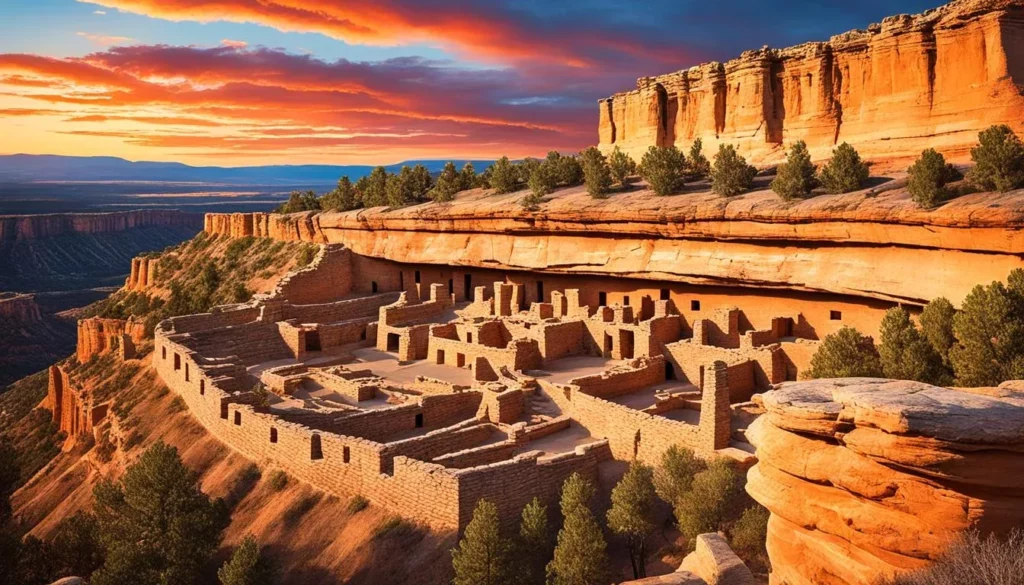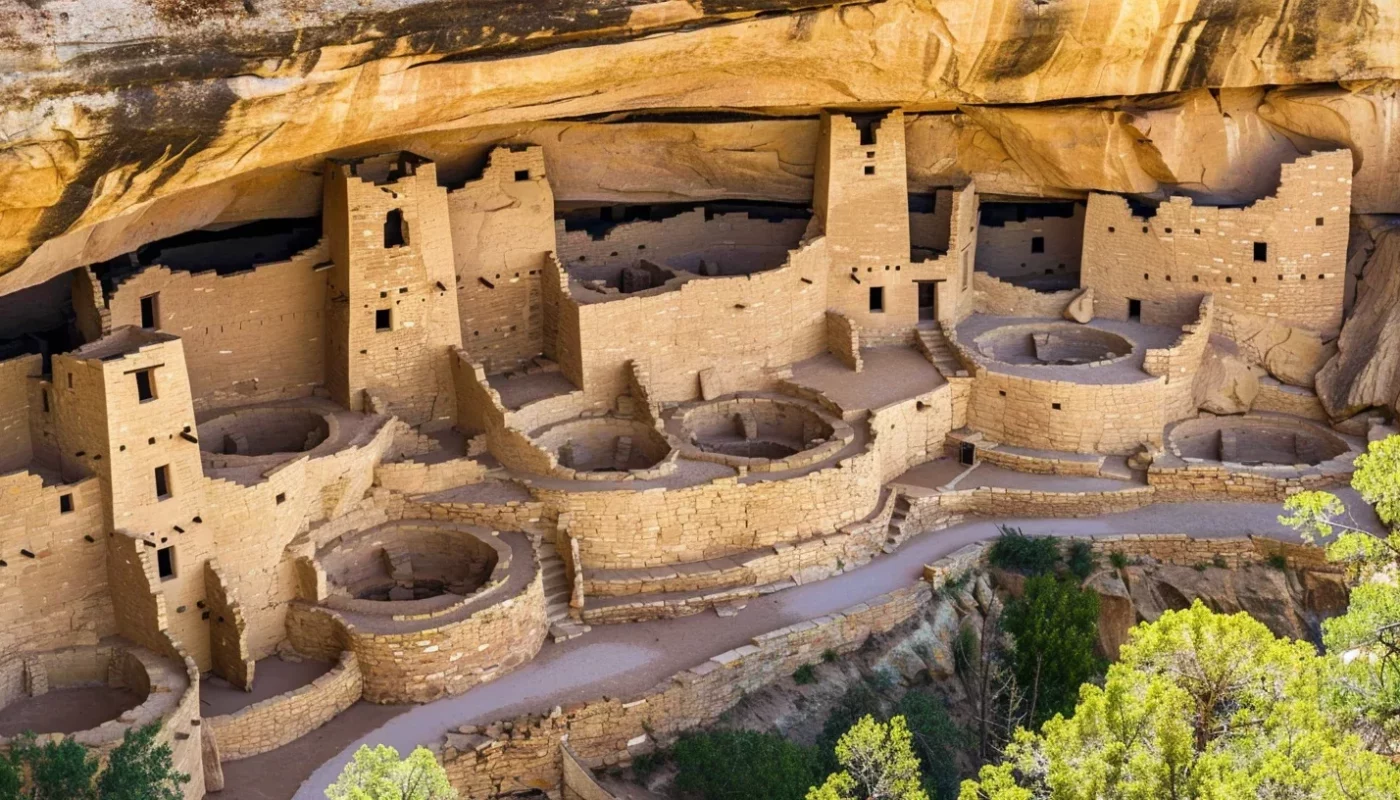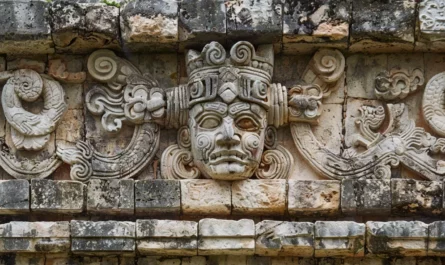Mesa Verde National Park is filled with history, having over 4,700 archaeological sites. This includes 600 cliff dwellings. President Theodore Roosevelt established it on June 29, 1906. It’s Colorado’s gift, focused on preserving ancient buildings. Mesa Verde gives us a peek into the Ancestral Puebloans’ world. They lived there from 550 to 1300 A.D.
Visiting Mesa Verde is like walking through time. You don’t just see old walls and rooms. You feel the past around you. This park shows how a long-gone civilization adapted and thrived until the 1300s. The ruins share stories of people in tune with nature, masters of building.
Today, keeping Mesa Verde safe is a big job. Work is done to shield these ancient wonders from damage. This helps make sure we can see and learn from them for years to come. Mesa Verde keeps teaching and amazing people from everywhere.
At Mesa Verde, the tales of the past are all around. See how the Ancestral Puebloans lived in this tough environment. Their story is still teaching and inspiring us.
The Establishment of Mesa Verde National Park
In an inspiring act, Theodore Roosevelt set up Mesa Verde National Park on June 29, 1906. This move was key for cultural preservation and saving natural resources. It kept the amazing ancient buildings made by Ancestral Puebloans safe for others to see in the future.
The park stands out as a top heritage site. It showcases the cleverness and traditions of humans over thousands of years. Its creation marked a big step in saving important historical stories and items. It mixes both culture and nature.
The park’s founding emphasized the need to save special buildings and old farming ways. This ensures that the Ancestral Puebloans’ tales and skills live on. It honors human creativity.
The Ancestral Puebloans: The Inhabitants of Mesa Verde
The Ancestral Puebloans made the Four Corners region their home. Mesa Verde was a key spot for them. They were skilled in stone masonry and farming, leaving a lasting impact on the area.
Who Were the Ancestral Puebloans?
The Ancestral Puebloans lived in the Four Corners. They built stone communities and mastered farming in a dry climate. Their homes evolved from simple pits to complex stone buildings, showing their creativity and skill.
Mesa Verde’s Archaeological Significance
Mesa Verde highlights the Ancestral Puebloans’ archaeological impact. It has many sites that tell stories of human creativity and endurance. Visitors see stone communities that go from basic to advanced, showcasing their history over time.
It’s vital to keep protecting these sites. By preserving them, we ensure that the Ancestral Puebloans’ stories inspire others. These efforts offer deep insights into early human life in the Four Corners.
The Cliff Dwellings: A Window Into the Past
The cliff dwellings of Mesa Verde show us the skill of ancient builders. Places like Cliff Palace and Spruce Tree House tell us about old ways of living. These homes, carved into canyon walls, show smart planning and community life.
Created by the Ancestral Puebloans, these homes are more than shelter. They let us see into a complex society with smart engineering. Every ruin gives clues about how people lived together, using the land wisely.
The Balcony House and Long House show how building methods and designs changed over time. Their locations also show the builders knew about defense and using resources well.
Efforts to save these dwellings add to their importance. By keeping them in good shape, conservationists help us and future generations. We can learn from and appreciate Mesa Verde’s cliff dwellings.
So, Mesa Verde’s cliff dwellings are key to understanding America’s past. They give deep insights into the architecture and community life of the Ancestral Puebloans.
Exploring Mesa Verde’s Mesa Top Sites
The mesa top sites at Mesa Verde show us how the first people lived long ago. We see their homes evolve from simple to complex. This change tells us a lot about their building skills and community life.

The Early Years: Pithouses and Pueblos
At first, the Ancestral Puebloans built pithouses that were partly underground. These homes kept them safe and warm. Over time, they started building pueblos above the ground. These had more rooms and could fit more people.
Masonry Towers and Farming Structures
One key feature of these sites is the masonry towers and farming areas. The towers had many uses, like defense and storing food. This shows they were smart about using what they had. They also made farming structures and water systems, proving their farming skills helped them live in Mesa Verde’s dry lands.
Keeping these places safe is important for us to understand our history. We need to look after these sites so others can learn about and admire the Ancestral Puebloans’ skills. Thanks to hard work in archaeology and site care, their achievements are honored and remembered.
Mesa Verde as a UNESCO World Heritage Site
Mesa Verde became a UNESCO World Heritage Site, a major honor. This status celebrates the park’s rich archaeological sites. They offer deep insights into the Ancestral Puebloan lifestyle. Mesa Verde stands as a crucial cultural site for the world, telling stories of human history and creativity.
Being a UNESCO World Heritage Site means Mesa Verde gets the protection it needs. This helps in keeping the ancient buildings and farming techniques alive. By doing this, we’re not just saving physical sites. We’re also preserving the stories they tell.
Mesa Verde is more than just old buildings; it’s a live history lesson. Every ruin and relic has a story. Its importance stretches far, making it key for education and attracting visitors from all around.
| Feature | Significance | Preservation Efforts |
|---|---|---|
| Cliff Dwellings | Unique ancient architecture | Structural stabilization projects |
| Mesa Top Sites | Evidence of early farming communities | Ongoing archaeological studies |
| Rock Art | Symbolic Puebloan communication | Documentation and restoration |
Carefully conserving Mesa Verde’s sites keeps their stories alive for the future. This effort pays tribute to the Ancestral Puebloans and aids in global cultural sharing.
Mesa Verde Tours: Guided Interpretive Experiences
Embarking on Mesa Verde tours connects visitors deeply with the Ancestral Puebloans’ ancient history and culture. These interpretive experiences boost your understanding of the park’s rich past. Guides share carefully crafted stories during hikes to remarkable archaeological sites.
Our guided tours give an intimate glimpse into Mesa Verde’s daily ancient life. The national park exploration features a walking tour of Cliff Palace. It’s the park’s biggest cliff dwelling, set in the natural canyon walls. This tour, open until October 22nd, provides deep insights into the ancient people’s architectural mastery.
Tours run daily from 8:00 am to 12:00 pm and 1:00 pm to 5:00 pm. Prices are $93 for adults and $73 for children aged 5-11. Children under 4 join for free. Each tour lasts about four hours, offering a thorough exploration of Mesa Verde.
By joining these guided tours, visitors trace the Ancestral Puebloans’ steps. They gain insights into their society, religious practices, and mysteries of their departure. These experiences highlight the need to preserve this cultural treasure for future generations.
Conservation is crucial for these programs. Efforts are ongoing to protect Mesa Verde’s archaeological sites. Participating helps keep the park’s history alive and accessible. It contributes to preserving this national park for the future.
The Timeline of Ancestral Puebloan Occupation
The history of the Ancestral Puebloan occupation at Mesa Verde is fascinating. It shows how they evolved in architecture and society. They started with farming and then built amazing cliff dwellings. These steps show how they lived in harmony with nature.
The Move to the Cliff Dwellings
In the late 1190s, the Ancestral Puebloans started building cliff dwellings. This move is a mystery to archaeologists. The dwellings show their masonry skills and how they adapted to the environment. These dwellings are well-kept and teach us about their lives.
The Southward Migration
In the late 13th century, the Ancestral Puebloans moved south. This migration is key to understanding their history. Scientists study various reasons for this move, like weather and social changes. They left behind sites that fascinate historians and tourists.
| Period | Development | Key Sites |
|---|---|---|
| Mesa Top Farming | Initial agricultural and settlement endeavors | Pithouses and early pueblo structures |
| Late 1190s | Transition to cliff dwellings | Cliff Palace, Spruce Tree House |
| End of 13th Century | Southward migration | Abandoned cliff dwellings, new settlements in the south |
It’s crucial to preserve these sites and understand the Ancestral Puebloans’ migration. Conserving these places helps keep their legacy alive. Efforts focus on keeping their history and structures authentic for future generations.
Preserving the Cultural Heritage of Mesa Verde
Mesa Verde National Park is a tribute to the Ancestral Puebloans, with around 5,000 archaeological sites. These sites give us a glimpse into their lives. It’s crucial to preserve this cultural heritage to share their legacy and stories with the world.
Preserving these sites involves careful archaeological work. This includes conservation and ongoing research. These actions help protect the sites from natural and human damage. This way, their ancient beauty remains intact.

Recent efforts have been on fixing the cliff dwellings. This work lets visitors see their complexity and beauty. These projects show our dedication to keeping Mesa Verde’s rich cultural heritage alive.
Conservation Projects: Protecting Cliff Palace
Cliff Palace is a breathtaking ancient site from the Ancestral Puebloan civilization. Its preservation is very challenging. Conservation projects at Mesa Verde National Park are crucial to keep this iconic site in good shape. These efforts make sure Cliff Palace stays beautiful and historical for all to see in the future.
There are many challenges this old structure faces. To help, Mesa Verde has set up several preservation initiatives. Conservation projects led by expert archaeologists use modern archaeological conservation methods. They work on keeping the structure stable and reducing damage from the environment, preserving its original beauty and importance.
Caring for ancient sites like Cliff Palace mixes old methods with new technology. Each piece is carefully checked and treated to keep changes small but effective.
These efforts include fixing parts of the palace and stopping problems before they start. Things like erosion, water harm, and the wear from many visitors are all watched closely. The goal is to keep Cliff Palace historically accurate and educational. By doing the least amount of change needed, they save as much of the original as possible.
Here’s a quick look at what these conservation efforts focus on:
| Threat | Preservation Strategies | Outcome |
|---|---|---|
| Environmental Erosion | Stabilization of cliffs and runoff management | Reduced structural risk |
| Visitor Impact | Guided tours and restricted access areas | Preserved site integrity |
| Water Damage | Improved drainage systems | Minimized water infiltration |
In summary, the continuous conservation projects at Mesa Verde show a strong commitment to Cliff Palace. With detailed preservation and archaeological conservation tactics, the ancestral spirit of this place lives on. These strategies ensure that future generations can enjoy and learn from this historic site.
Conclusion
Visiting Mesa Verde National Park is a deep dive into the Ancestral Puebloans’ ancient history. This park covers over 52,000 acres of mesas, canyons, and plateaus. From heights between 6,000 and 8,500 feet, visitors get stunning views and reflect on the area’s rich past.
The Ancestral Puebloans thrived here for over 700 years, from 600 to 1300 CE. They left behind cliff dwellings and sites that show us their life and society. These ruins give us a clear picture of their world, making the past come alive for us.
The park’s also known for its diverse plants and animals adapted to the dry Southwest. You’ll find everything from juniper trees and piñon pines to colorful wildflowers. Animal lovers might see mule deer, elk, coyotes, and even golden eagles. It’s a good idea to book tours early, especially to see places like Cliff Palace and Balcony House.
Keeping Mesa Verde safe is crucial for both its culture and nature. Efforts to preserve nearly 5,000 sites help keep our heritage safe for the future. When we visit or study these sites, we’re part of preserving Mesa Verde’s history and education.




